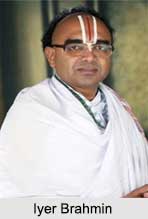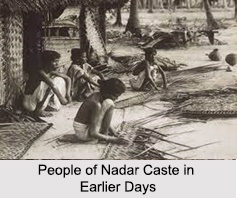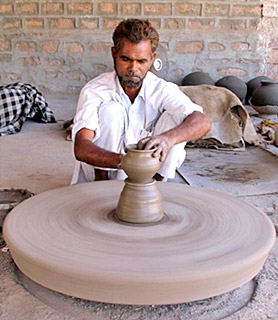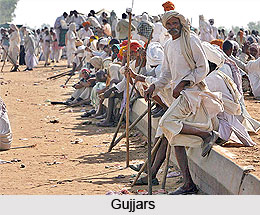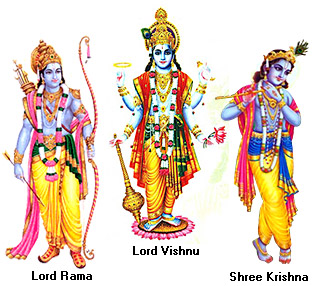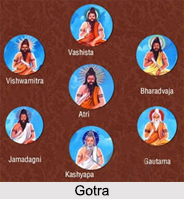Introduction
 Vastu Shastra is a logical Indian science that deals with the ancient tradition of architecture. It is the science of construction and the traditional Hindu architectural system where the emphasis is laid in the directional alignments. Vastu Shastra, as is practised presently, is based on the 125 verses contained in "Brihat Samhita" of Varahamihira. This very point indicates the vital link between Jyotish and Vastu.
Vastu Shastra is a logical Indian science that deals with the ancient tradition of architecture. It is the science of construction and the traditional Hindu architectural system where the emphasis is laid in the directional alignments. Vastu Shastra, as is practised presently, is based on the 125 verses contained in "Brihat Samhita" of Varahamihira. This very point indicates the vital link between Jyotish and Vastu.
Hindu philosophy considers nature and God synonymous; hence, it becomes all the more significant to build a home according to the principles of Vastu Shastra so that man can exist harmoniously with nature. There are 2 main branches of Vastu Shastra: "Manav Shilpa Shastra" relating to construction of buildings and "Deva Shilpa Shastra" dealing with the principles of constructing temples etc.
Origin of Vastu Shastra
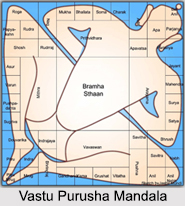 The origin of Vastu Shastra is steeped in legends. It is said that Lord Brahma was the first recipient of this knowledge from Lord Shiva as a part of the Vedas, just like He received the knowledge of "Jyotish". And then the knowledge of Vatu Shastra was gradually spread through the munis, seers and sages of ancient India. However, traditionally the foundation of Vastu is ascribed to the mythical sage Mamuni Mayan.
The origin of Vastu Shastra is steeped in legends. It is said that Lord Brahma was the first recipient of this knowledge from Lord Shiva as a part of the Vedas, just like He received the knowledge of "Jyotish". And then the knowledge of Vatu Shastra was gradually spread through the munis, seers and sages of ancient India. However, traditionally the foundation of Vastu is ascribed to the mythical sage Mamuni Mayan.
Vastu Shastra in Ancient Texts
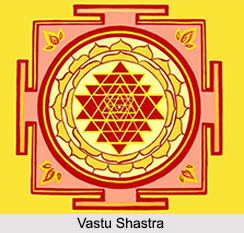 Vastu Shastra or Shilpa Shastra finds numerous references, implicit and explicit in the ancient texts, like, the Vedas, Brahmanas, Upanishads and Indian Puranas. Vastu Shastra is derived from the verb `was` meaning `to dwell`, or place of residence. Vastospatu the lord of a house is a deity in the Rig Veda. It also applies to conveyances, furniture and all constructed structures. The principal Vastu, however, is the ground on which others rest.
Vastu Shastra or Shilpa Shastra finds numerous references, implicit and explicit in the ancient texts, like, the Vedas, Brahmanas, Upanishads and Indian Puranas. Vastu Shastra is derived from the verb `was` meaning `to dwell`, or place of residence. Vastospatu the lord of a house is a deity in the Rig Veda. It also applies to conveyances, furniture and all constructed structures. The principal Vastu, however, is the ground on which others rest.
The sacred writings are arranged in four groups: (1) the Vedas; (2) the Upavedas or Supplementary Vedas; (3) the Vedarigas or Limbs of the Vedas; and (4) the Upangas or Supplementary Arigas. The four Upavedas are: (1) Ayurveda, or the science of life and medicine, derived from the Rig Veda; (2) Gandharva Veda, or the science of music, derived from the Sama Veda; (3) Dhanur Veda, or military science, derived from the Yajur Veda; and (4) Shilpa or Sthapatya Veda, or the mechanical arts and architecture, derived from the Atharva Veda.
The text-book of Vastu Shastra are records of oral traditions which go back into an undefined past. The Brihat Samhita, for instance, compiled by Varahamihira in the middle of the sixth century A.D., is based on the authority of Master Architects Maya, Visvakarma, Gargya and Manu. It is the earliest datable source on Vastu Shastra.
The Visvakarmanvaya-pradipika explains that creation is another name for Shilpa, and the origin of Shilpa or `form` is Brahma, Tvastra and Prajapati put together, called Visvakarma. Visvakarma is Prajapati as the universal constructive principle. He is called Visvakarma because he created the activity of everything. The five heads of Visvakarma are Sadyojata, Vamadeva, Aghora, Tatpurusa an Isana, representing East (Rig Veda), South (Yajur Veda), West (Sama Veda), North (Atharva Veda) and North-East (Pranava Veda), respectively. The fifth direction North-East arose from the middle of these four heads. While destroying he is called Rudra, while protecting Lord Vishnu and while creating he is known as Lord Brahma.
Vastu Shastra, in its fullest exposition, belongs to aesthetics. Three prominent schools of philosophy had deep theoretical impact on the evolution of philosophical postulates in Indian aesthetics, viz. Rasabrahma-veda, Nadabrahma-veda and Vastubrahma-veda.
The Atharvaveda, however, refers to six regions or lokas and their six respective guardians - Lord Agni (South), Indra (East), Lord Varuna (West), Soma (North), Vishnu (Fixed quarter) and Brihaspati (Upward quarter). In the Krishna Yajur Veda (Taittiriya Samhita) the same six regions and their respective regents are mentioned, but Vishnu is replaced by Lord Yama.
The Manusmrti explains the eight lokapalas thus: Soma (Chandra), Agni Arka (Surya), Anila (Vayu), Indra, Vispati (Kubera), Appati (Varuna) and Yama. In this list Surya and Soma have been enumerated in place of Nirrti and Isana of the later Puranic texts. The Gobhila Grhyasutra, while describing the rites connected with building of a house, states that offerings should be made to the regents of ten regions (disas), namely, Indra (East), Vayu (South-East), Yama (South), Pitr (South-West), Varuna (West), Maharaja (North-West), Soma (North), Mahendra (North-East), Vasuki (Nadir) and Brahma (Zenith).
The Buddhist texts speak of only four lokapalas: Dhrtarastra (East), Vidudhaka (South), Virupaksa (West) and Vaisravana (North). The Matsya Purana further says that a house having only two rooms on the West is very auspicious, and that with those on the South is inauspicious.
The Rig Veda postulates only water as the primordial element or matter, from which the other five elements of later philosophy evolve. Varuna is the upholder of physical and moral order. By his power of Maya he sends forth dawn and makes the Sun (who is also described as his eye) traverse the sky. Varuna, with Mitra, is most frequently invoked as the bestower of rain. Dual divinities like Mitra-Varuna and Dyava-Prthivi are a special characteristic of the Rig Veda. The release of waters and the breaking forth of dawn or emergence of light are described as simultaneous events originating from the same source. These waters are described as moved upwards by Indra when set free for movement after killing of the demon Vritra. Their onward movement is, as described in the Rig Veda, where seven rivers are said to flow into the jaws of Varuna as into a surging abyss or ocean. The universe is said to have consisted of nothing but undifferentiated waters in the beginning. This cosmic circulation of celestial waters is also stated in the Zend Avesta, the Greek and Egyptian mythologies.
The Vastu Shastra Upanishad is more fundamental than the other known texts. It is a profound study of the principles of origin of the `how` and `why` of form figuration and of its ultimate necessity and purpose. Dealing exclusively with the composition and layout of sculpture, it contains an esoteric doctrine, in which the production of Shilpa is considered as a sacrificial act. In sage Pippalada`s conception, the language of form is equivalent to the spoken or written word or `Vak` giving expression to a vision of divine truth.
Etymology of Vastu Shastra
The expression Vastu Shastra has its root in the Sanskrit term "Vastu" which means any really existing or abiding substance or essence. In the context of this ancient science of architecture, "Vastu" also mean the site or foundation of a house, site, ground, building or dwelling-place or habitation. The term "Shastra" however means science, doctrine or teaching.
Principles of Vastu Shastra
Vastu Purusha Mandala
An integral part of Vaastu Shastra is formed by "Vastu Purusha Mandala" which refers to the diagrammatic and mathematical concepts to generate designs. It comprises metaphysical plan of the building including the supernatural forces. "Purusha" refers to power, energy, soul or cosmic man while "Mandala" means any chart or plan symbolically representing the cosmos.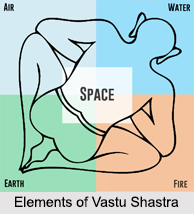
Omens of Vastu Shastra<
Omens of Vastu Shastra : It is believed that both positive and negative forces prevail in nature. Vastu Shastra helps in generating the positive forces within the building. There are several norms that can help an individual built a house where he or she will be able to derive mental peace.
While applying Vastu Shastra one must remember that it is important to follow its norms while buying a plot of land or a building. According to this science the earth is divided primarily into East, West, North and South and the sub directions South-east, South-west, North-west and North-east. Every direction has its own importance in Vastu Shastra. Based on these 8 directions, the principle of "Ashta Sutra" has been formulated. Each of these direction are said to be controlled by a particular Hindu god. Based on this notion Vastu Shastra advices what kind of construction should take place in each of these directions.
Besides these, Vastu Shastra also deals with numerous norms that can guide an individual to select and buy a proper plot or house. Several ways are suggested to deal with accursed buildings, auspicious and inauspicious omens and others. Whether there are problems with a Junction plot, L type plot, building material or the flat system, Vastu Shastra has all kinds of solutions to problems related to such elements. Unifying science, art, astronomy and astrology, it can be said that Vastu Shastra is perfect as an ancient mystic science for designing and building.
Vastu Shastra in Astrology
 Vastu Shastra is one of the branches of Hindu Astrology. The Rishis of yore should have thought deeply on the karakatva of the planets or their significations in formulating the principles of Vastu. The principles given by the Acharyas are of eternal nature in the changing world. The characteristics of the karakatva of planets cannot be changed. Keeping in view the natural laws, the Rishis have given the basis to build houses, temples, cities, etc. By following these principles of Vastu, i.e., the karakatva of planets in building dwelling places, one can get peace and tranquillity and general happiness in ones lives.
Vastu Shastra is one of the branches of Hindu Astrology. The Rishis of yore should have thought deeply on the karakatva of the planets or their significations in formulating the principles of Vastu. The principles given by the Acharyas are of eternal nature in the changing world. The characteristics of the karakatva of planets cannot be changed. Keeping in view the natural laws, the Rishis have given the basis to build houses, temples, cities, etc. By following these principles of Vastu, i.e., the karakatva of planets in building dwelling places, one can get peace and tranquillity and general happiness in ones lives.
The whole world is a manifestation of the Pancha- Bhutas or Pancha-tattvas, viz., Prithvi, Apa, Tejas, Vayu and Akasa. The Akasatattva works in higher dimensions of life, whereas the four basic Tattvas, viz., Prithvi, Apa, Teja, Vayu, are of great utility in man`s day-to-day life. He himself is a product of the Panchamahabhutas. The house in which he dwells has three components of the Tattvas and if proper rules are not followed, there will be all likelihood of suffering with anxieties in life. In the day-to-day life human beings carry on various daily activities. These can be grouped under Sattvika, Rajasika and Tamasika natures. Each direction and a portion of the house are earmarked for the different department of life, keeping in view the planetary Karakatvas. If this rule is transgressed, there will be confusion and those dwelling in that place will encounter many problems of health and monetary affairs. Even for the mutual understanding between members of a family, there will be differences and stress.
The East direction is ruled by the Sun, and the West is ruled by Saturn. In the same way, the North is ruled by Mercury, and the South is ruled by Mars. The North-East is ruled by Jupiter, and the South-East is ruled by Venus. The North-West is ruled by the Moon, and the South-West is ruled by Rahu.
East: The Sun, who rules this direction, is the promoter of health and that is why the sun-rays should enter a house early in the morning. Therefore, one has to keep doors and windows properly to get the sunlight in a house. Windows are, therefore, ruled by the Sun and the Moon who are called the luminaries, which, in other words, are planets responsible for light in human life, and more specifically, physical and mental health. The life-giving principles of the Sun should be followed by keeping doors and windows open so that the sunrays enter a house as the morning Sun has a property of purifying water. The entry of sunlight in the morning is life-protecting, and as the Sun goes up, his destructive force comes into play. By evening when it comes down, it again has a soothing influence. If by chance the kitchen is located in the East of the house, Venus being the enemy of the Sun, the housewife may suffer from bilious complains and nervous debility, and also there may be uterine disorders.
West: Saturn is the presiding deity of the West direction. This direction is very suitable for locating the dining room which will bring auspicious influence to the family. The person who has the main door in this direction will have come up from great difficulties and he ekes out his livelihood by physical labour as Saturn stands for labour and hard work. To keep food-grains in this direction is good.
North: Since the North is ruled by Mercury which is a planet of the mind, education etc., one can keep the study-room in this direction, in addition to the treasury of wealth. The presiding deity Mercury who is symbolic of Lord Vishnu is the Lord of Wealth. If the main door is kept in this direction the head of the family will be intelligent and will earn his living through business enterprises or intellectual activities as Mercury stands for buddhi the karakatuas for consultation and communication are good here. Generally, this is a good direction to keep the money-chest.
South: The South direction has Mars as its lord. This is the best direction for the bedroom. The husband-governing planet Mars and the wife-governing planet Venus are both friendly to each other. This, therefore, is a good direction for them to sleep and is very conducive to deep attachment and understanding between them. When the kitchen and the bedroom are in one direction, the couple will experience a lot of mental unrest. It is also not good lo take food in this direction as they may suffer ill-health or other ailments. This direction is called the direction of the god of Death.
North-West: Vayu is the presiding deity of this direction. Vayu is the god of Wind, and the ruler is the Moon. If the main door is towards this direction, the lord of the house will have many travels. This is a very good place for storage of food-grains.
South-West: This direction is ruled by Rahu. This is the place where the toilet has to be built. If by chance the walls of this direction are dilapidated, there will be visitations of spirits.
North-East: This direction is ruled by Jupiter and the presiding deity is Iswara. This is the place where divine contemplation is done. Idols of worship should be kept in this direction. The owner of the house will have high honour, respect and prestige in society. It is said that the room and the bathroom in this direction will ensure auspicious results and will promote longevity, good health, good fortune and peace of mind.
South-East: The presiding deity of the South-East is Lord Agni, the god of fire, and Venus is the governing planet of this direction. If the kitchen is kept in this direction, there will be peace and tranquillity in the family. If by chance there is an overhead tank or large accumulation of food particles in this direction corners, the house-wife and her daughters will suffer from ill-health.
Hence according to Vastu it has been said that to understand the good and bad aspects of different portions of the house, one has to understand the permutations and combinations of major planets and sub-planets joining them. In order to understand this, one has to identify each planet with different portions of the house. The Sun and the Moon representing the windows are found on the right and left side of the front portion of the house. The inside hall of the house is identified with Mars, Venus with the bedroom, Saturn with the store-room, and Ketu with ventilation of the front door. Generally speaking, Ketu represents the conservancy, stagnant water or a ditch. The moon generally stands for cowshed and also storage of grains. Though Saturn is also a planet connected with storage, he represents Bhutaganas, which means, living beings who consume food. Therefore, the West direction is meant for dinning room. In addition to mercury`s jurisdiction of the hall in the house, he represents the treasury room where treasures of the house in the form of jewels, money, cash and documents are kept. It may be also called as strong-room where the iron-chest is kept. Rahu, the ruler of Nirrtya is a planet ruling waste material. Therefore, the lords of eight directions are Indra (East), Agni (South-East), Lord Yama (South), Lord Varuna (South-West), Sani (West), Kubera (North), Iswara (North-East), and Vayu (North-West).
Importance of Vastu Shastra
Vastu Shastra is of paramount significance in Indian culture and it has a rich heritage. Land is the most important criterion in Vastu. Vastu is also classified into different categories on the basis of Jati and Varna. In Jati there are the Devata, Manava and Raksasa. In Varna we have Brahmin, Kshatriya, Vaisya and Sudra. A careful study of Vastu reveals that the whole movement of Vastu was genuinely and positively scientific, the ultimate goal being spiritual. Vastu, though mainly akin to the earth, is also concerned with other Mahabhutas. Hence, based on the pronounced effect of different Bhutas, lands can also be classified.
The classification of Vastu according to the parameter Jati principally has to do with structural elegance and material management. The classification of Vastu in accordance with Varna mainly has a professional view and cultural needs.
Vastu has remained so important right from ancient India that it finds mention in Agamas, such as the Karnikagama, Suprabhedagama, Vaikhanasagama, etc., and works on Tantra, such as the Hayasirsa Tantra, Kiranas-tantra, and Puranas such as the Agni Purana, Matsya Purana and Vishnu Purana and a lot more.
Vastu principles are more or less common all over India, living from times immemorial as a cultural entity. Vastu has retained its traditions for thousands of years and it is as relevant today as it was when first propounded. There are also Vastu texts for Jainism and Buddhism, such as, the Gautamiyam, Bauddhamatam and Chaitya. The Vastu Silpa traditions are purely Indian in its fundamental concepts and currency.
In Vastu much importance is given to the Sun`s movements in the heavens in placing the construction of a house in such a manner that more open space is left and more windows and doors are provided towards east and north than towards west and south so that a house is exposed to maximum influence of solar energy.
Modern engineers, house builders and architects will be surprised to know how our Vastu experts devised simple methods and most inexpensive contrivances for examining a site, measuring and taking possession of it, orientation, etc. They are advised to study carefully what is called Ayadivarga. This is said to enable one to find out the fitness of the structure and ensure well-being of both the builder and owner. Terms like Dhwajava, Sirhhaya, Vrsahhaya, Gajaya, etc., are said to be auspicious; while those like Dhumdya, Svdndya, Khardya, etc., are inauspicious.
Vastu Shastra is important in the construction of houses because if proper science of Vastu is not followed in the construction of houses. For instance no house of the shape of a triangle should be built as it is said to cause early death to the owner and it should not remain unused for long time.
Other important rules are given for the construction of public buildings. According to the Gupta-Vastu, when constructing schools and other teaching places, walls in the East and North must be constructed first. The Southern and Western walls are to be constructed next. It is also advisable to have a common wall for two buildings. There are other helpful hints. For instance, if an old house is to be reconstructed only new wood should be used. Nor should one use old wood for a new construction. There is no aspect of human habitat - homes, factories, offices, etc., which cannot find a place in the Vastu scheme.
Finally it can be said that Vastu is important in all kinds of construction because it brings about harmony in the building and when there is harmony in the construction itself it is natural that there will be peace in all things that are done in the building and also the people residing in the building will have a sense of fulfilment.
Arvana in Vastu Shastra
Vastu Shastra is part and parcel of ancient astrological science. It is not a separate branch. The construction of a village (village plan) or the house must, therefore, be studied in relation to Astrology or in relation to the movements of the Sun and other planets.
Some modern-day scholars have come out with strange theories saying that Grama-arvana (village plan) or Griha-arvana need not be observed. But this is not supported by Vastu principles. The theories enunciated in them are true and applicable for all times. The validity of theories can be verified with actual experience.
Grama-arvana (Plan of Village)
A road should be marked latitudinally from the East to the West and another road should also be marked from the North to the South longitudinally. The roads intersect each other and four parts of the village are formed. The four parts are traditionally allotted to the four Varnas-Brahmin, Kshatriya, Vaisya and Sudra. The Brahmin division is allotted to Acharyas, artists and men of intellectual calling. The Kshatriya division is meant for political leaders, government employees and such other men in general. In the Vaishya division live the merchants, industrialists and other business men. The Sudra division is meant for unskilled labourers in agriculture and industry. If men construct their houses in their allotted divisions, according to their professions, they can live in harmony and peace. This Grama Arvanam is scientific and conducive to the well-being and development of all classes of men.
Griha-arvana
Business shops should be arranged in the Raja-vithi. Some shops will face each other; some facing South and other facing north. Residential streets should run parallel to the Upa-raja-vithi, from North to South, with a distance of 132 feet. Half of this length, i.e., up to 66 feet, will have house plots, which will face East and other houses will face west. The width of these plots will be 33 feet. Thus, the streets will stretch from the North to the South and the houses will face the East and the West in every street.
The direction of the house of person is decided by the first letter of his name. There are 12 Rasis, out of which Mesa, Karkataka, Sinha, Vrischika, Dhanus and Meena are opposite to the other six Rasis, viz., Tula, Makara, Kumbha, Vrsabha, Mithuna and Kanya. The lords of the first six Rasis are Mars, Moon, Sun and Jupiter belong to Guru Varga and they are friendly to one another. They are lords of the 1st, 5th and 9th houses. Similarly, the lords of the other Rasis are Venus, Saturn and Mercury. These three planets are friendly to one another. They are known as Sani Varga planets not only in the Zodiac but also in the Asta-dik Chakra.
The Sun is the lord of the East. Therefore those who are born in Guru Varga should live in houses facing East (purva-simha-dvdra).
Saturn is the lord of the West. Those who are born in Sani Varga Lagna should live in houses facing West (pascuna-strhha-dvdra).
The East facing and the West facing doors are alone called Simha-dwaras, because they are in the path of Sun. The North facing and the South facing doors are not Simha-dvaras. These are only side doors.
The lord of the East direction is the Sun, and the lord of the South is Mars. These two planets are friends. So East Simha-dwara house must have the side door on South and also some open place in the South. The lord of the West is Saturn and the lord of North is Mercury. These two planets are friends. So the West Simha-dvara house must have the side door in the North and also some open space.
For business shops, those who are born in Guru Varga Lagnas should have South facing shops and those born in Sani Varga Lagnas should have North facing shops. If they do not follow this arrangement, and if their shops are in contrary directions, the good planetary results will be reduced by 50 percent, the bad effects will be aggravated by about 50 percent.
Relevance of Muhurta in Vastu Shastra
 Muhurta normally means auspicious time at which various events of life are fixed. Muhurta is as important as the methodology of building construction. As per Vastu Shastra, an auspicious time for fixing the main-door frame, for digging the earth and the Griha-pravesam after the completion of the building plays an important role in one`s life.
Muhurta normally means auspicious time at which various events of life are fixed. Muhurta is as important as the methodology of building construction. As per Vastu Shastra, an auspicious time for fixing the main-door frame, for digging the earth and the Griha-pravesam after the completion of the building plays an important role in one`s life.
Vastu says that if a house is commenced on the first tithi, there is poverty, if on the fourth lunar day, loss of wealth, if on the eighth day eviction, and if on the ninth day, danger from weapons. It has also been said that the Lagna at the commencement of the building should not be flanked on either side by malefics and Upagrahas. The bad days caused by tithis and weekdays and Naksatras, and those prohibited for marriage- muhurtas are prohibited for Grharambha also.
The Vastu Chakram is as follows:
The stars from that occupied by the Sun indicate the different reckoned parts of the body as follows:
1-3 Stars - Forehead
4-7 Stars - Front toe
8-11 Stars - Heel
12-14 Stars - Back
15-18 Stars - Region under right shoulder
19-22 Stars - Back (tip of the spinal region)
23-25 Stars - Region under left shoulder
26-28 Stars - Face
With regard to the relevance of Muhurta in Vastu Sastra it has been said that if the star falls on the forehead, fire accident takes place; if on the front foot, prosperity of the house; if on the heels, permanency; if on the back, financial benefits; if under the right shoulder, all types of profits; if on the tip of the spinal region, the owner will suffer very badly including destruction; if under the left shoulder, poverty; and if on the face, permanent problems.
Some of the important aspects of Muhurta and Vastu are:
It is said that:
Construction of the entrance of Labour Room should never be undertaken during Chara Lagna and Cam Navamamsa.
The Upasraya house (third, sixth, tenth or eleventh) from Janma Rasi, as well as the eight sign from it should not be the rising sign for starting construction.
Vastu says that if Jupiter is in Lagna, the Sun in the sixth, Mercury in the seventh, Venus in the fourth, and Saturn in the third, the house constructed will last for hundred years.
Similarly if Jupiter is in the fourth from the Ascendant and Moon in the tenth, Mars and Sun in the eleventh, the house constructed in such a Lagna will last for eighty years. If Venus is in the Ascendant, Jupiter in the fifth, Mars in the sixth, Sun in the third, the house constructed will last for two hundred years.If Jupiter and Venus are in Lagna and Mars in the sixth and Sun in the eleventh, the house constructed in such a Lagna will last for two hundred years.
Vastu Shastra has also talked about various other positions of the planets and similarly has also explained various Muhurtas. For instance it has been said that if Venus is in exaltation in the Lagna or Jupiter is exalted in the fourth and exalted Saturn is in the eleventh, the house will last for many thousand years.
If the Moon is placed in Karka, i.e. Cancer Lagna, Jupiter in a Kendra and benefics in friendly or exalted houses, the house commenced during such a Lagna will last long and will be a wealthy house.
The house commenced in the star Pusya, Uttard Phalguni Uttarasadha, Uttarabhadrapada Aslesa, Mrgasirsa, Sravana, Rohini or Purvabhadrapada will be a house of wealth. Vastu Sashtra states that the house commenced in Visakha, Chitra, Satabhlsa, and Punarvasu, when the Venus is in Dhanisthd, that house will always have the granaries full. A house commenced in Hasta, Uttard-phalguni, Chitra, with Mercury in Asvini and Anuradha, will bestow financial happiness to children.
Engineering and Architecture in Vastu Shastra
An approved plan is necessary for every new construction. If the plan is as per Vastu Shastra, it is immediately acceptable and there are several instances that have proved that the construction work progresses rapidly.
One of the foremost principles of construction work is that it should not be done in a hurry. Creating a building involves a large sum of money and effort. Therefore even a trifle mistake can ruin all the plans and dreams. So it is advisable that an individual waits for the right and auspicious time and then start the construction work. Once the work starts, there should be no break in it. The construction work should be stopped after sunset and working at night must be definitely avoided.
The mason should look up towards the south and then stop work. This will prove beneficial for the owner of the house. An outhouse in the south-west corner must also be built for keeping the building material. Out-house can also be built in the south-east corner leaving a margin of at least 2-3 feet from the east and the south directions. The watchman should preferably live in the southeast out-house. If he is in the north-west out-house, there is always a danger of theft. If the watchman is kept in the south-west out-house, they try to override the owner. Of course, it is advantageous, to build the outhouse, immediately after the construction of the well. the main building should be constructed only after the construction of the compound wall.
While building the house the advice of a professional is always useful. The concerned person can always put in his expert opinion, for instance, the exact requirement of steel to be used. These kinds of advices must always be taken into account.
Vastu Sastra in Town Planning
According to Vastu the site of a town should be selected at the bank of a river, sea shore or lake. The site should be surrounded by milky trees, full of fruits and flowers. The Eastern side of the town should be lowered to get sun rays on the door fronts. The site should not be selected on the Western side of a mountain. The capital of the state should be selected at the centre of a town classified as: Stanya, Dronamukha, Kharvitika, Sarhgrahana.
Shapes of Town
Vastu Sastra recommends five shapes of towns:
1. Chandura (square)
2. Agatara (rectangle)
3. Vritta (circle)
4. Krittta Vritta (elliptical)
5. Gola Vritta (full circle)
A city resembling a diamond (octagonal) should be regarded as inauspicious. If the front part of the city is in the shape of a bow, it is very good and auspicious. The Agni Purana recommends highly the semi- lunar shape of the town. The holy city of Banaras is situated on the convex side of the Gangetic belt and presents a semilunar phase. Nanjangud town near Mysore also is situated on the convex side of the river Kapila. The Matsya Purana says that the semilunar shape of a town is not auspicious. The development of industrial factories at Nanjangud brings the shape of the town to a semilunar aspect. This is not auspicious. The factories may become sick.
The engineer should consider the weather records of the area for the past ten years in designing any building. From the weather records obtained from the meteorological centre of the region, we can understand the influence of the site affected by the weather. If the buildings are designed considering the facts like I the weather data, wind velocity and its direction, rainfall, evaporation, humidity of the area, sunlight and maximum and minimum temperature, etc., it will satisfy most of the specifications of Vastu.
The Agni Purana says that the semilunar shape of the town is only useful for a riparian town, but not for a cosmopolitan city of the now developed Nanjangud.
The Matsya Purana says that the semilunar shape of the town will have a weak defense. People will be too selfish and expect too much with too little effort. In general, the semilunar shaped town will face much difficulty in power, water supply, drainage, transport and communications and most of the factories will become sick.
Vastu Shastra in Modern Architecture
 The modern knowledge identified with civil and structural engineering covers the construction and strength characteristics of a dwelling. The size, location and orientation characteristics of the dwelling and its components are viewed usually from the angle of Vastu. It is important to note that certain overlapping as well as conflicting of requirements are possible when one wants to achieve the knowledge of the two worlds by integrating the modern discipline with the Vedic treasure-house of information.
The modern knowledge identified with civil and structural engineering covers the construction and strength characteristics of a dwelling. The size, location and orientation characteristics of the dwelling and its components are viewed usually from the angle of Vastu. It is important to note that certain overlapping as well as conflicting of requirements are possible when one wants to achieve the knowledge of the two worlds by integrating the modern discipline with the Vedic treasure-house of information.
Vastu has been into existence since the ancient times but with modernisation changes have come about in the perspective of Vastu. For instance the simple but a significant structural member identified as straw by Vedic architects is identified to-day by the high-tech engineering as cable. Straw signifies stretch by tension. Cable also signifies stretch by tension.
Vastu Shastra states that every civil and construction engineer should be aware that the load transfer from the roof to the brick wall is primarily through compression.
Further, the ancient architects were familiar not only with structural engineering but also with the construction technology related to building materials. Such a discovery makes one believe that the modern day Vastu Shastra is somewhat reinventing the wheel that existed in the Vedic period.
As per as the implication of Vastu Shastra in the modern day is concerned it can be said that the use of Vastu in the modern day will result in enhancing the quality material and spiritual quality of life in today`s troubled world. As the results of the application of Vastu Sastra spread around our environment, it will remind an individual that the Vedic science and technology are not time related subjects but are eternal.
Finally it can be said that Vastu Shastra in the modern age is not completely different from the one that was used in the ancient era but the way is different and the approach is different but altogether modern day Vastu Shastra used in today`s architectural construction is derived from the Vedic sutras.










